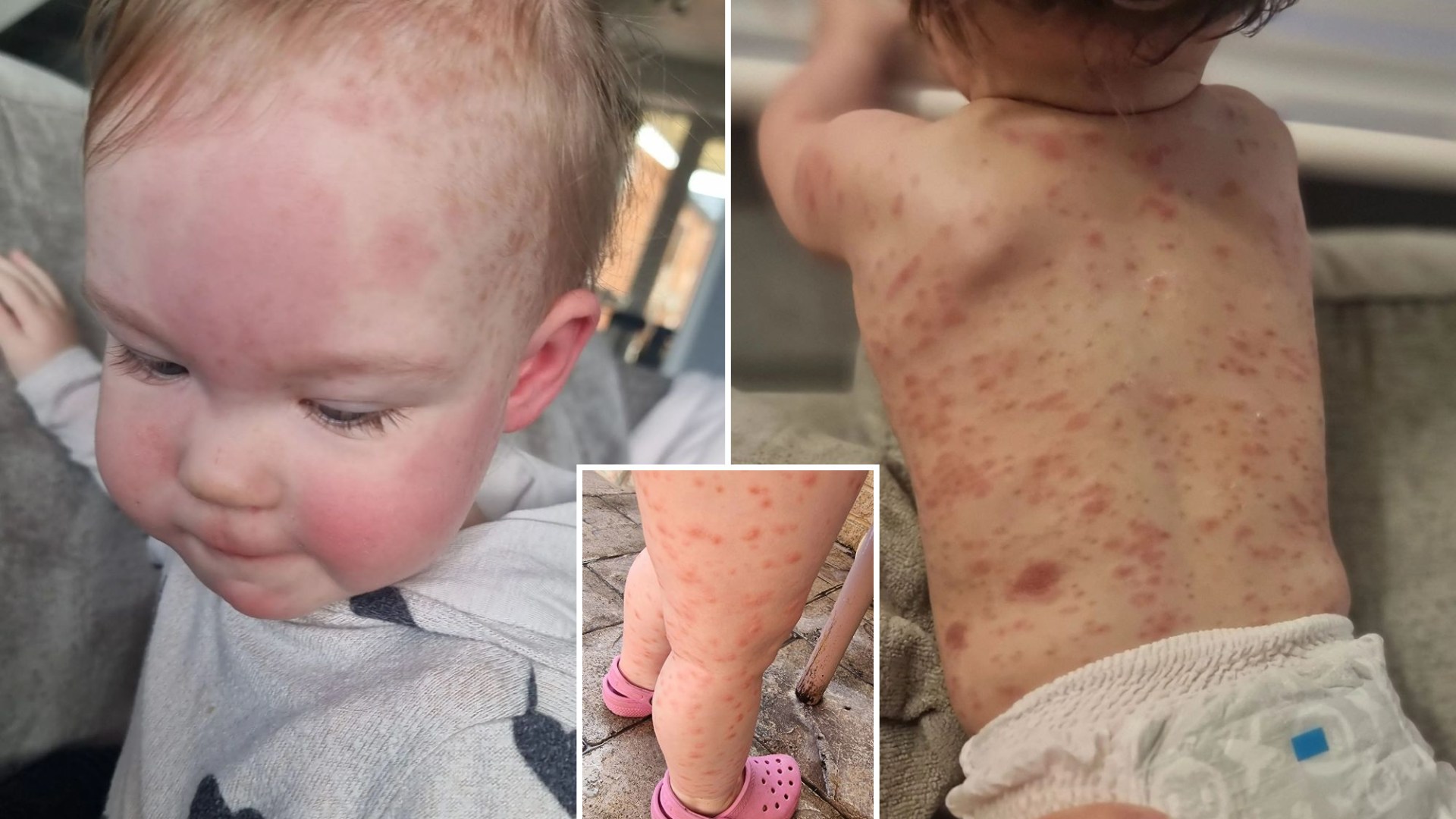A HEARTBROKEN mum claims parents drag their children away from her “contagious-looking” tot – but she has a rare disorder that makes her allergic to ticking and hugging.
Laura Smith was concerned and confused when her three-month-old Willow-Rae began breaking out in red marks across her back and chest.
10

10

10

10
The 30-year-old said doctors blamed the spots on allergies, eczema, birthmarks and chicken pox – but the blemishes continued to spread.
Laura, who lives in Stockton-on-Tees, County Durham, tried changing Willow-Rae’s diet, swapping cleaning products and removing medications.
But nothing seemed to impact her baby’s perplexing flare-ups.
As Willow-Rae became covered head-to-toe in angry, red spots, Laura faced questions from other parents who pulled their children away from her toddler out of fear she could be contagious.
Read more on rare conditions
The tot was eventually referred to a dermatologist.
After months of unanswered questions, Laura was finally told that her 17-month-old had mastocytosis – a rare condition caused by an excess number of mast cells gathering in the body’s tissues.
Mast cells are produced in the bone marrow and are release histamine into the bloodstream when they detect allergens, causing an allergic reaction.
Laura, who owns an online gift store, learned what ‘triggers’ could cause a flare-up in Willow-Rae.
They include: certain foods, sweating, teething, cuddling, tickling, and getting upset or too excitable.
People with mastocytosis also have an increased risk of developing a severe and life-threatening allergic reaction, meaning Willow-Rae could go into anaphylaxis at any moment during a flare-up.
Laura said her daughter’s condition has put her ‘on edge’ – but wants Willow to have as normal a childhood as possible.
Laura said: “I’m on edge to even cuddle her because it can cause an allergic reaction.
“We still give her cuddles and put her emotional needs above this because she’s still a baby but we do need to be careful about not rubbing her too vigorously.
“Even things like tickling her can cause a flare-up. We are managing it a lot better now.

10

10

10

10
“Because excitement can trigger her, when we were to take her out to soft play, we had to get her to sit down for ten minutes because she had a flare up.
“It’s a constant battle. We still want her to have a childhood but still have to be mindful that little things can trigger her.
“It’s hard to get people to understand that we’re not being overprotective parents.
“It’s really scary. She loves playing in the garden but I have this massive fear that there’s bees around and if she’s stung that can cause an overload of histamine.
“Too much histamine in her body can cause an anaphylactic shock. We’re learning what she can and can’t tolerate.”
‘HEARTBREAKING’
Laura said parents often ask if Willow-Rae is contagious and even pull their own children away from her at soft play centres.
Laura said: “The most difficult part for me is how she gets treated by adults. Some people will approach us and ask if she has chickenpox.
“We’ve noticed people pull their children away from her because they think she’s contagious.
“We went away last week and got asked about 15 times if she was contagious.
“We’ve been shopping in Morrisons and people have come up to us asking if she’s contagious.
“As a mum, it makes me sad. I don’t want her growing up having to deal with those questions. It’s heartbreaking.
What is mastocytosis?
Mastocytosis is a rare condition caused by an excess number of mast cells gathering in the body’s tissues.
Mast cells are produced in the bone marrow – the spongy tissue found in the hollow centres of some bones – and live longer than normal cells.
They’re an important part of the immune system and help fight infections.
When mast cells detect a substance that triggers an allergic reaction, they release histamine and other chemicals into the bloodstream, causing blood vessels to expand and making the surrounding skin itchy and swollen.
There are two types of mastocytosis – cutaneous, which mainly affects children, and systemic, which mainly affects adults.
The most common symptom of cutaneous mastocytosis is abnormal growths on the skin, such as bumps and spots, which can form on the body and sometimes blister.
People with mastocytosis have an increased risk of developing a severe and life-threatening allergic reaction, the NHS states, due to the high number of mast cells and their potential to release large amounts of histamine into the blood.
The cause or causes of mastocytosis are not fully known, but there’s thought to be an association with a change in genes known as the KIT mutation.
There’s no cure for mastocytosis, so the aim of treatment is to try to relieve the symptoms.
Symptoms of cutaneous mastocytosis
Skin lesions are a characteristic of cutaneous mastocytosis.
Types of lesions known to occur in cutaneous mastocytosis include:
- Small areas of skin that change colour (macules)
- Small, firm, raised bumps (papules)
- Larger raised, red bumps (nodules)
- Large raised areas of skin noticeable to the touch (plaques)
- Blisters – which mainly affect young children with mastocytomas (tumours consisting of mast cells) or diffuse cutaneous mastocytosis (a rare form of cutaneous mastocytosis)
Lesions usually develop on the trunk and limbs rather than the head and neck.
The lesions, known as urticaria pigmentosa, are usually reddish-brown in colour, and can range from 1mm to several centimetres in size.
Stroking the affected areas of skin can make it swollen, itchy and red over the lesion.
Source: NHS
“If people do ask questions, I’m very open to answering them, they just don’t have to ask them in a rude way.”
Willow-Rae is luckily only experiencing three or four flare-ups a week now compared to six or seven before her diagnosis thanks to antihistamines.
But Laura is still hoping her little one will outgrow the condition in later life.
Laura said: “I have a massive hope in my head that she’ll grow out of it.
“We’re just living day to day with it at the moment. It’s affected all aspects of our life.”

10

10




